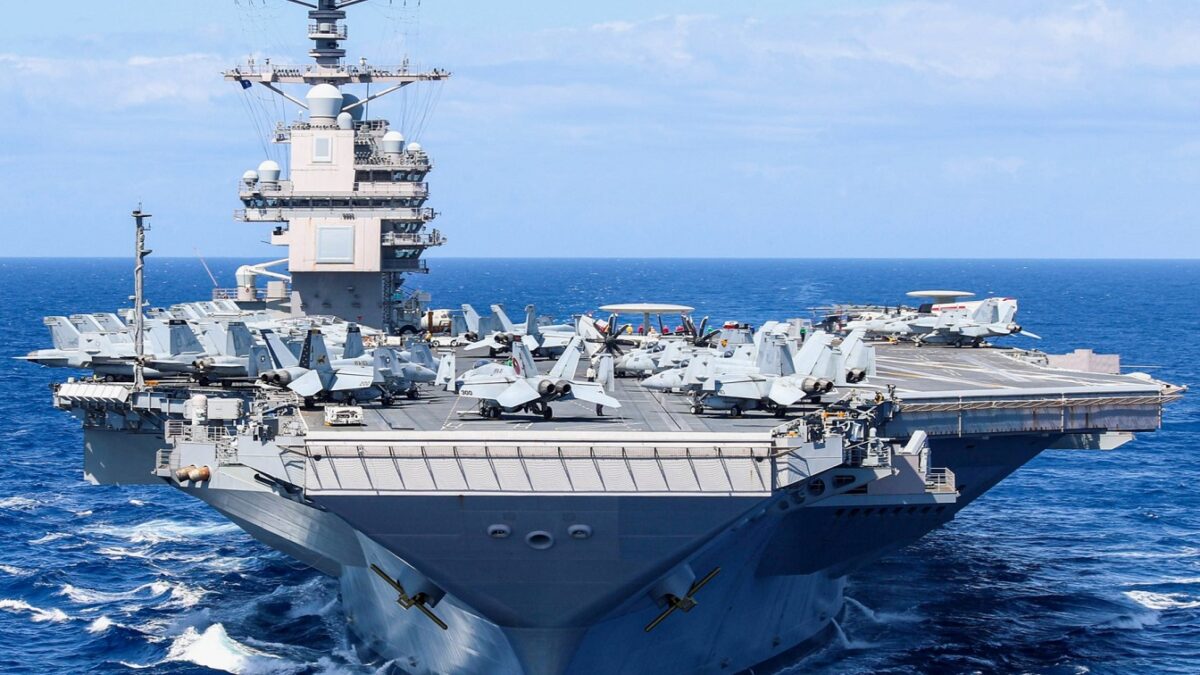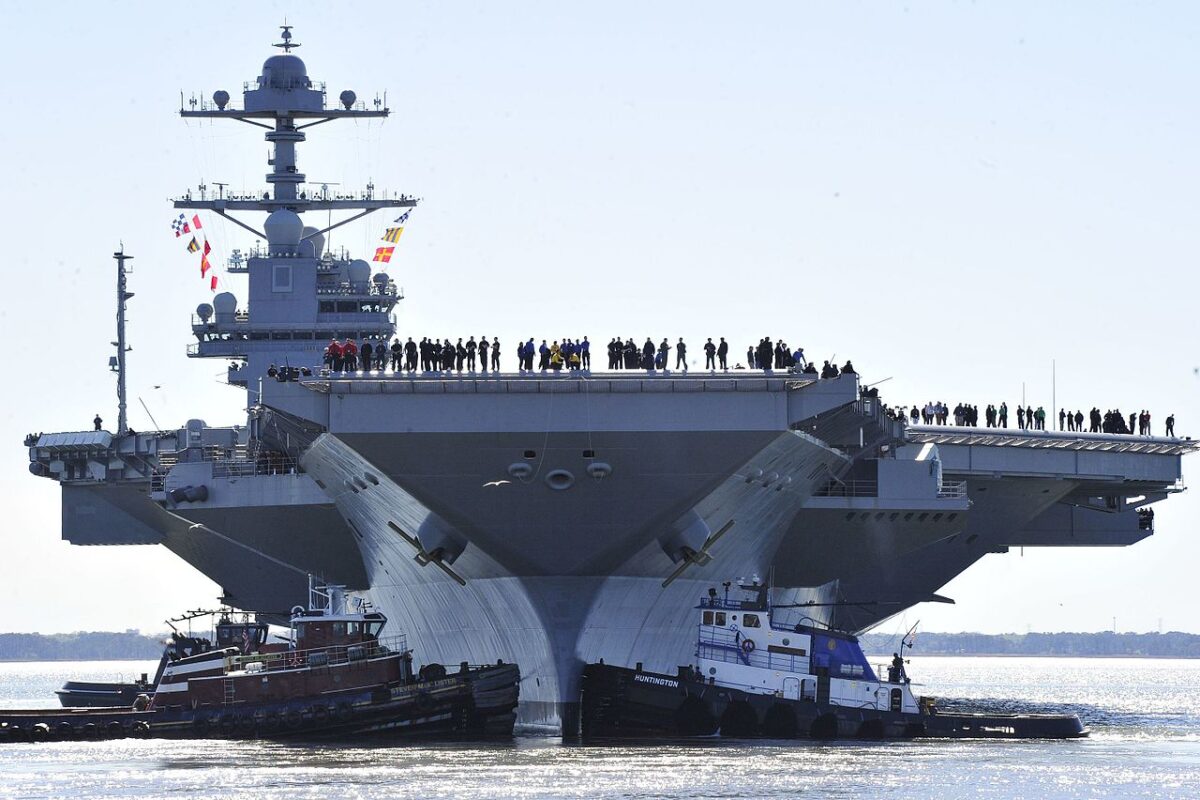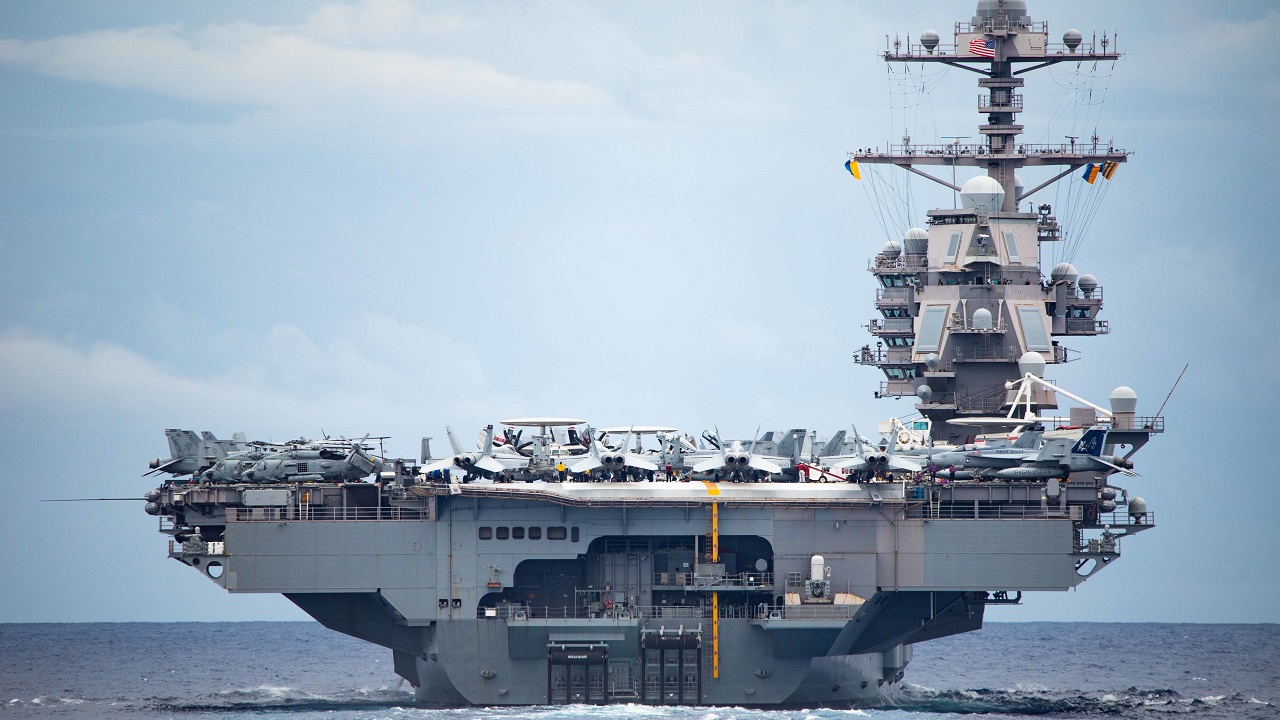In an age of global surveillance and long-range precision strike weapons, recent wargames have reanimated an old argument about the survivability of aircraft carriers. Critics have long asserted that large surface ships, especially aircraft carriers, are too vulnerable to play an effective role in a high-end conflict with China.
If true, this is problematic for U.S. defense planners, as so much of the U.S. military’s striking power in the Indo-Pacific region is tied up in the carrier strike group built around the nuclear-powered aircraft carrier (CVN). At the very least, the argument goes, the surface Navy would be pushed back as far as the so-called second island chain. From there, U.S. carrier aircraft will lack the range to assist Taiwan if China attacks or initiates a conflict along the first island chain.
But reality is much more complex than what wargames can reflect. The military forces on both sides are currently in a state of flux. The U.S. military is investing heavily in capabilities and forces intended to both address the growth in China’s military power and counter specific threats deployed by that country. Ultimately, the outcome of a conflict will depend on how the forces on both sides are deployed and employed.
The focus on CVN vulnerability is, at least to a degree, misplaced. No warship is invulnerable. During its last conflict with a major power, Japan in World War Two, the U.S. Navy lost four fleet carriers relatively early in the war. In addition, many more were damaged. The U.S. Navy ‘s decision to place its aircraft carriers in harm’s way led to the defeat of Japan in the Coral Sea, at the Solomon Islands, and at Midway. Moreover, these losses, or those in any wargame, must be judged against the outcome. Both in World War Two and in a fictional wargame the U.S. and its allies achieved their objectives.
The results of recent wargames that modeled a Chinese attack on Taiwan and the defense of that island by the U.S. and its key Indo-Pacific allies were not particularly surprising, although they were certainly concerning. Both sides sustained heavy losses in ships, planes, and personnel. For the purposes of this discussion, what was most noteworthy was the loss of at least two U.S. CVNs operating in the Western Pacific within range of Chinese anti-shipping missiles. It should be noted that despite these losses, China’s effort to seize Taiwan was ultimately defeated.
CVNs Matter: Why the U.S. Navy Needs Aircraft Carriers in a China Fight
There are five reasons why the CVN and the carrier strike group will be able to address the evolving Chinese threat in the Indo-Pacific and continue to provide the U.S. with vital global military power.
The first reason is mobility. Unlike fixed facilities, ships can move. This makes them difficult to track, which provides inherent survivability. In a matter of hours, a CVN with a top speed of 31 knots can move several hundred nautical miles or more, creating a zone of uncertainty for any adversary attempting to target it. The carrier strike group can use its mobility to operate as a stand-in/stand-out force, posing a continuing threat to adversaries’ forces and installations. As it seeks to use the vast ocean spaces of the Indo-Pacific to enhance survivability, the strike group can also “go dark,” limiting its emissions in order to deny Chinese sensors the ability to home in on electronic signals.
The second reason the CVN will remain a major contributor to U.S. military power is the revolutionary transformation the carrier air wing is undergoing. This transformation includes the deployment of the stealthy F-35C Lightning II, the E-2D Advanced Hawkeye airborne early warning aircraft, the tiltrotor CMV-22B Osprey, enhanced variants of the F/A-18E and F/A-18F Super Hornet fighters, the EA-18G Growler electronic warfare aircraft, and the MQ-25A unmanned aerial tanker. In the not-too-distant future, the Navy plans on fielding the F/A-XX sixth-generation aircraft. This new platform will have higher speed and longer range than current stealth aircraft, as well as advanced passive and active sensors, plus the command, control, and computing systems to support manned aircraft and control unmanned aerial systems.
The third reason is that the Sea Services are taking steps to change the way their forces are organized and deployed in order to defeat China’s A2/AD strategy. The Navy is building on the concept of Distributed Maritime Operations (DMO) and investing in Project Overmatch technologies to fight and win in new ways. According to a senior Navy strategist, “DMO is a combination of distributed forces, integration of effects, and maneuver. DMO will enhance battle space awareness and influence; it will generate opportunities for naval forces to achieve surprise, to neutralize threats and to overwhelm the adversary; and it will impose operational dilemmas on the adversary.” Project Overmatch is intended to provide Navy assets with the sensors and networks to support distributed operations and rapid sensor-to-shooter connectivity.
The Marine Corps’ plan to operate stand-in forces along the first island chain within range of the Chinese A2/AD system will contribute to the effectiveness of DMO. Agile, forward-deployed Marine Corps units will operate anti-ship missiles, air defense systems, and a variety of sensors with which to collect intelligence and targeting data to pass to other units and platforms.
Improvements in fleet air and missile defenses are yet another reason the carrier strike group will not just survive but flourish in the next several decades. The Navy has been steadily improving its sensors, adding the advanced, highly versatile SPY-6 in a variety of configurations to both existing and new surface combatants. It has also been improving its electronic warfare program and deploying new weapons systems such as the Standard Missile 6. Enhanced sensor-to-shooter connectivity will be vital to countering Chinese air and missile threat to the CVN.

Ford-Class. Ford-Class Aircraft Carrier USS Ford.
The final reason the CVN, and naval forces in general, will be able to operate effectively in the Western Pacific is the ability of the U.S. military to break the Chinese kill chain. There are many ways to do this, including attacking and jamming sensors, disrupting networks, flooding the theater with drones and decoys, and using cyber weapons to corrupt data. The U.S. military is working on these and other measures to deny the individual elements of the kill chain.
The Aircraft Carrier Isn’t Going Anywhere
The aircraft carrier has been a major component of U.S. military power for more than 80 years, even as threats to their survival have evolved. This is because of the U.S. Navy’s ability to redesign the CVN, incorporate new technologies into the carrier air wing, and alter tactics and techniques for employment of the carrier strike group. The CVN and the carrier strike group will remain a force for China to reckon with for the foreseeable future.

NEWPORT NEWS, Va. (April 8, 2017) – Pre-Commissioning Unit Gerald R. Ford (CVN 78) Sailors man the rails as the ship departs Huntington Ingalls Industries Newport News Shipbuilding for builder’s sea trials off the coast. The first- of-class ship—the first new U.S. aircraft carrier design in 40 years—will spend several days conducting builder’s sea trials, a comprehensive test of many of the ship’s key systems and technologies. (U.S. Navy photo by Chief Mass Communication Specialist Christopher Delano).
Author Biography and Expertise
Dr. Daniel Goure is Senior Vice President with the Lexington Institute, a nonprofit public-policy research organization headquartered in Arlington, Virginia. He is involved in a wide range of issues as part of the institute’s national security program.

